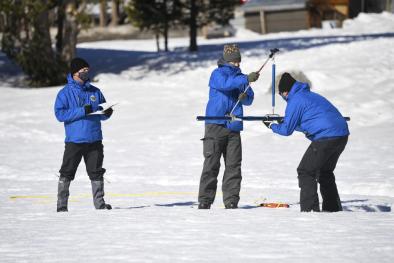Science Source
Structure and Detectability of Trends in Hydrological Measures over the Western United States
- Examines the geographic structure of observed trends in key hydrologically relevant variables across the western United States at 1/ 88 spatial resolution during the period 1950-99
- Identifies geographical regions, latitude bands, and elevation classes where these trends are statistically significantly different from trends associated with natural climate variations
- Analyzes the following variables: late-winter and spring temperature, winter-total snowy days as a fraction of winter-total wet days, 1 April snow water equivalent (SWE) as a fraction of October-March (ONDJFM) precipitation total (precip(ONDJFM)), and seasonal (JFM) accumulated runoff as a fraction of water-year accumulated runoff
- Finds that large trends (magnitudes found less than 5% of the time in the long control run) are common in the observations and occupy a substantial part (37%-42%) of the mountainous western United States
- These trends are strongly related to the large-scale warming that appears over 89% of the domain
- Finds that the strongest changes in the hydrologic variables, unlikely to be associated with natural variability alone, have occurred at medium elevations (750-2500 m for JFM runoff fractions and 500-3000 m for SWE/Precip(ONDJFM)) where warming has pushed temperatures from slightly below to slightly above freezing
- Further analysis using the data on selected catchments indicates that hydroclimatic variables must have changed significantly (at 95% confidence level) over at least 45% of the total catchment area to achieve a detectable trend in measures accumulated to the catchment scale
Related Content
Headline

Feb 2, 2022 | AP
Dry January means less water than normal in California snow
Headline

Jan 25, 2022 | Climate Nexus Hot News
Air Pollution, Lack Of Snow, Hang Over Winter Olympics
Headline

Dec 21, 2021 | High Country News
Winter without snow is coming
Science Source
| Proceedings of the National Academy of Sciences
Global snow drought hot spots and characteristics
Huning and AghaKouchak


